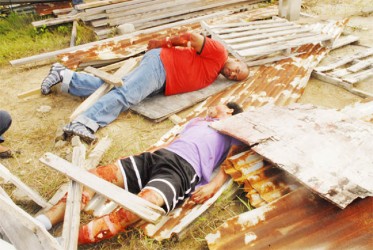With urban Guyana currently experiencing a surfeit of major construction, Safety and Health expert and Director of the private consultancy Optimum Safety Solutions Dale Beresford wants the Ministry of Labour to step up inspections at construction sites to ensure that there are adequate measures in place to identify safety hazards and that preventive action is taken.
“Construction sites present special challenges to worker safety and while the increase in construction work is an indicator of development there is a need to build into the process a regime that is strongly biased in favour of workers,” Beresford said.
Stabroek Business sought Beresford’s comments in the light of reports of a number of recent accidents at construction sites in the city. In one instance, a Labour Ministry official denied that an accident had taken place at a major work site after this newspaper had secured evidence to the contrary.
Beresford told Stabroek Business that at a time when several major buildings were under construction “employers need to have strong safety programmes in place” that include worker training in “understanding and following procedures.” He said the goal of such training should be to raise awareness amongst workers in the construction industry to help them identify and eliminate safety hazards.

Beresford said Labour Ministry inspectors should check “fall protection equipment as well as trench safety, equipment safety, and power lines.” He added that if such inspections unearthed “a lack of protection or a serious hazard” they should “stop work at that site until the hazards are abated.”
And according to Beresford, proactive safety and health programmes are an effective way of preventing workplace injuries and illnesses and reducing the cost of doing business. “Such arrangements mean that employers and employees work together to ensure that safety and health are always among the key considerations on the construction site.”
Beresford told Stabroek Business that the benefits of effective, proactive safety programmes include higher productivity and employee morale, better quality work, fewer worker injuries, lower compensation and insurance costs and reduced absenteeism.
With most of the major structures being concrete Beresford said construction workers should be made aware of the various injuries and illnesses that are common in the concrete construction sector including burns, rashes, and skin irritations resulting from exposure to cement dust or wet concrete. Silicosis is a respiratory disease caused by inhaling silica dust during such operations as concrete cutting, drilling, grinding and sandblasting.
Beresford also said that workers in the concrete sector were vulnerable to broken bones, lacerations and crushing injuries resulting from falls from elevated work surfaces; impalement and impact from falling objects, form and shoring failure, and structural failure of components of the project.
“Because the hazards associated with concrete construction are great, employers must ensure that workers use appropriate personal protective equipment and that they conform to safe work practices at all times,” he said.
And in the wake of recent worksite accidents, Beresford said that major projects should be required to have emergency medical services “readily available” He said first aid kits should be provided by each employer on all job sites and must contain the minimum supplies as determined by an authorized licensed physician.
The contents of the first-aid kit should be inspected regularly to ensure that the expended or expired items are promptly replaced.
He added that in a professional environment trained personnel in possession of a valid Red Cross First Aid certificate or its equivalent should be immediately available at the job site to provide first aid treatment.
And according to Beresford, Labour Ministry inspections should also ensure that construction sites adhere to rules pertaining to workers’ access to sufficient amounts of cool potable water. He said that ideally employees should make at least one quart per employee per hour available, that the water should be provided at no cost to the workers and that sufficient supplies of water should be placed as close to employees as possible.




